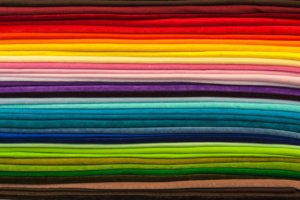The Fabric Lamination Process and Its Applications

We’ll give you a quick overview of fabric lamination in this article. First, let’s take a look at the basics of laminated fabric and learn how your business can put it to use.
What is Laminated Fabric?
Ultimately, laminated fabric can refer to any of several types of textiles made from multiple bonded layers. In the fabric lamination process, a manufacturer combines multiple layers of fabric or film together. Then, using heat and pressure, they convert them into a single unified product.
Typically, the purpose of laminating a fabric is to give it certain properties. Waterproofing is one of the most common applications for fabric lamination. The laminating machine attaches a waterproof film and a breathable membrane over a substrate fabric. Other times, manufacturers might add reflective film to safety clothing or spill barriers to restaurant tablecloths.
Many different types of fabrics can be laminated. For instance, woven cotton is one of the most common types. Often, you’ll find laminated cotton in a huge variety of garments. Likewise, there are other types of laminated fabric including polyester and non-woven cotton.
Understanding the Fabric Lamination Process
The fabric lamination process uses a laminating machine to create laminated fabric. Every process is somewhat different, depending on the needs of the individual material. Here’s the basic idea behind laminating fabric goods:
- Initially, the manufacturer preps the fabric using an adhesive coating specially designed for lamination.
- Then, workers feed the coated fabric and any additional layers (such as a poly film) into a laminating machine.
- Finally, the heat and pressure from the laminating machine seals the fabric, layers, and adhesive into a single multi-ply web.
Use Cases for Laminated Fabric
What are the most common ways that businesses put laminated fabric to work? Here are just a few of the major use cases for laminated fabric:
- Consumer outerwear garments
- Workwear and safety apparel
- Automotive interiors and cover cloths
- Tablecloths and other decorations
- Upholstery fabrics
- Industrial and automotive hoses
With so many different use cases for laminated fabric, many manufacturers need to be able to create it. Next, let’s look at how these manufacturers find custom lamination solutions.
Can I Laminate Fabric at My Manufacturing Facility?
Occasionally, businesses have the resources available to laminate fabric using existing capacity. Others can retrofit their current conversion manufacturing facilities to laminate fabric in-house. However, adding laminating capacity involves a significant capital investment.
Thus, for many businesses, it’s far more cost-effective to work with a contract manufacturer. A great contract laminator can provide the lamination services your business needs on demand. You’ll save money and have the advantage of working with experts in the field of laminating.
Expert Fabric Lamination Services from CTI
Conversion Technologies International is a leading contract manufacturer for all kinds of lamination processes. In fact, fabric lamination is just one of the many specialty lamination services that we offer. And, because our production lines are designed for modular implementation, our fabric lamination processes are incredibly versatile.
Custom laminating is one of our specialties, and we’ve designed custom fabric lamination solutions for manufacturing’s biggest names. Our facilities include extensive R&D capacity that will help you refine your fabric lamination process. Plus, your lamination project will get the attention it deserves from conversion manufacturing professionals.
Other Ways CTI Can Help with Your Production Needs
Better yet, our capability goes beyond laminating. We also provide the following services:
Adhesive and General Coatings:
We provide coating applications for many industries. Materials that we work with include acrylic, acetate, latex, silicone and neoprene. Our on-site experts work with water-based adhesives, hot melts, water-repellent, fire-retardant and spray adhesives.
We can handle cure temperatures up to 350°F, widths up to 120 inches, roll weights up to 2,000 lbs. and maximum adhesive thickness of 60 mil.
Slitting and Die-Cutting:
CTI also offers some of the best fully-customizable slitting and die-cutting services in the country. Our equipment includes several flat-bed die cutters; therefore, we can cut from sheet or rolled form.
Additional Specifications:
- Cut materials up to 5/8”
- Sheet sizes up to 40” x 60”
- Rolled materials up to 60” width
Research and Development:
We can also help with research and development of your product.
Many large companies prefer to focus on their core business and not staff and equip an entire research and development department. After all, that can be very expensive. Similarly, small companies have an even greater desire to focus their budget on the products or services they provide rather than researching their creation. Typically, they can’t devote large sums of money to research and development.
Ultimately, by using the services of a contract manufacturer, companies of all sizes benefit from an off-site R&D lab. Fortuitously, CTI offers these services for a wide variety of industries. Moreover, we enjoy the process of assisting with the development of a new product. Plus, we gladly handle the manufacturing end when needed. Our flexibility allows us to fit into your supply chain wherever you require our services to make the process seamless.
Get Started Today!
CTI will be happy to get you started with a free quote for fabric lamination or any other service. Find your custom fabric lamination solution today and call us at 419-924-5566, or contact us online!
- << < Previous Post
- 1
- 2
- ...
- 93
- ...
- 240
- 241 Next Post > >>

